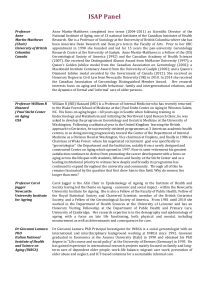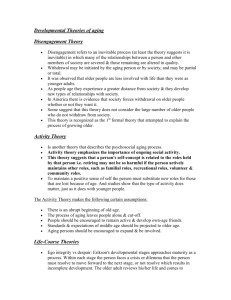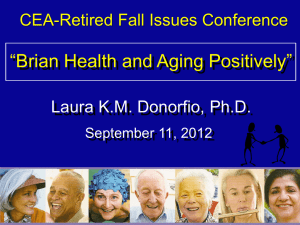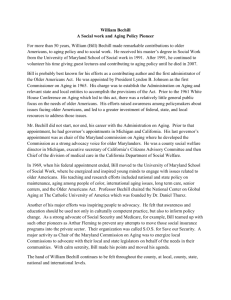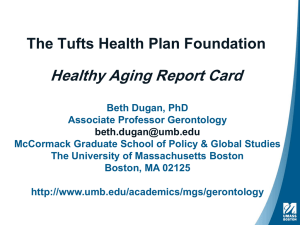SHARP Target Audience - GeroNet
advertisement
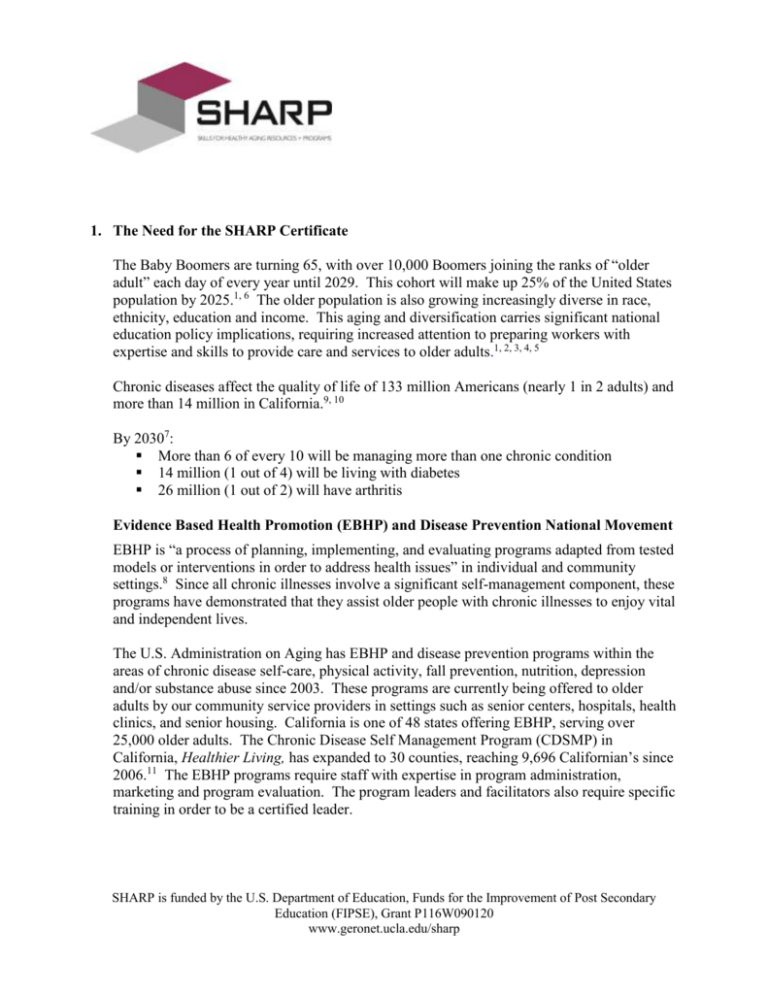
1. The Need for the SHARP Certificate The Baby Boomers are turning 65, with over 10,000 Boomers joining the ranks of “older adult” each day of every year until 2029. This cohort will make up 25% of the United States population by 2025.1, 6 The older population is also growing increasingly diverse in race, ethnicity, education and income. This aging and diversification carries significant national education policy implications, requiring increased attention to preparing workers with expertise and skills to provide care and services to older adults.1, 2, 3, 4, 5 Chronic diseases affect the quality of life of 133 million Americans (nearly 1 in 2 adults) and more than 14 million in California.9, 10 By 20307: More than 6 of every 10 will be managing more than one chronic condition 14 million (1 out of 4) will be living with diabetes 26 million (1 out of 2) will have arthritis Evidence Based Health Promotion (EBHP) and Disease Prevention National Movement EBHP is “a process of planning, implementing, and evaluating programs adapted from tested models or interventions in order to address health issues” in individual and community settings.8 Since all chronic illnesses involve a significant self-management component, these programs have demonstrated that they assist older people with chronic illnesses to enjoy vital and independent lives. The U.S. Administration on Aging has EBHP and disease prevention programs within the areas of chronic disease self-care, physical activity, fall prevention, nutrition, depression and/or substance abuse since 2003. These programs are currently being offered to older adults by our community service providers in settings such as senior centers, hospitals, health clinics, and senior housing. California is one of 48 states offering EBHP, serving over 25,000 older adults. The Chronic Disease Self Management Program (CDSMP) in California, Healthier Living, has expanded to 30 counties, reaching 9,696 Californian’s since 2006.11 The EBHP programs require staff with expertise in program administration, marketing and program evaluation. The program leaders and facilitators also require specific training in order to be a certified leader. SHARP is funded by the U.S. Department of Education, Funds for the Improvement of Post Secondary Education (FIPSE), Grant P116W090120 www.geronet.ucla.edu/sharp California’s Need for Workforce Preparation According to the Aging Labor Force Study conducted by the California Social Work Education Center, most employed in public social services do not have any formal training related to aging.12 60% of CA County Welfare Departments have NO staff with formal training in aging. 61% of Aging Network Services agencies do not have employees with formal training in aging. 2. SHARP: Skills for Healthy Aging Resources and Programs SHARP is funded by the U.S. Department of Education, Funds for the Improvement of Post Secondary Education (FIPSE) for three years, 2010-2012. This pilot program was designed with collaborative grant partners College of the Canyons, Santa Barbara City College, Partners in Care Foundation, National Council on Aging, California Geriatric Education Center and the California Council on Gerontology and Geriatrics. Together, SHARP has created the 4-course, 12-unit certificate to be offered in Fall 2011 and Spring 2012! The ideal SHARP student will take all four courses at once. Courses are scheduled to be offered in the afternoons so students can work during the day, and during Block 2, participate in 60 hours of Internship/CWEE (Cooperative Work Experience Education) at a community agency. 1 2 3 4 5 BLOCK 1 (6 weeks) GERO 101 GERO 102 6 7 8 9 10 11 12 13 14 BLOCK 2 (10 weeks) GERO 103 GERO 104 15 16 SHARP… Is the only college program to prepare personnel to work in community-based aging services and agencies that offer evidence-based health promotion and disease management programs. Focuses on the latest evidence for what works in promotion of older adult’s health. Establishes positive partnerships with community organizations, such as local senior centers, faith based organizations, and health care organizations. Offers a unique set of skills and experience that currently doesn’t exist in any other college program in the nation. Meets the needs of students to gain practical skills in a short amount of time to work in the community with older adults. Provides the opportunity to receive FREE training to become a Certified Chronic Disease Self-Management Program (CDSMP) or Healthier Living Leader. Offers exposure and contacts with various employment pathways in the health and social service professions. SHARP is funded by the U.S. Department of Education, Funds for the Improvement of Post Secondary Education (FIPSE), Grant P116W090120 www.geronet.ucla.edu/sharp GERONTOLOGY 101: Introduction to Healthy Aging Catalog Course Description Examines the physical, psychological, and social issues associated with the aging process and reviews aspects of healthy aging among older adults. Student Learning Outcomes At the end of the course, the student will be able to differentiate the current social, political and economic demographic shifts occurring in U.S. society and how they are shaping the “Aging of America”, as well as identify social policies affecting older adults. Students will be able to compare and contrast the various biological, psychological, and social conditions that can lead to both healthy and non-healthy aging among older adults. Students will also be able to compare and contrast how the variables of class, gender, race, and ethnicity affect one’s ability to age healthy, as well as affect their accessibility to medical care and/or social services. Specific Objectives 1. Evaluate national, state and local governmental policies and legislation that have historically shaped social policy, services, and programs related to older adults. 2. Differentiate between services offered through in-home care, adult day care, and longterm residential care and assess the appropriateness of “fit” for older adults based on need and financial accessibility. 3. Distinguish the various social, medical, and economic programs and policies that assist older adults in U.S. society. 4. Distinguish between normal changes of aging and diseases of late life. 5. Analyze the impact of taking multiple drugs on the elderly. 6. Formulate a plan that would promote healthy aging. GERONTOLOGY 102: Behavior Change Theories and Practices Catalog Course Description This course examines behavior change, processes, and motivational theories, as well as negotiation and motivational interviewing, group dynamics, and communication skills with older adults. Student Learning Outcomes At the end of the course, the student will be able to develop a personal philosophy and style of working with diverse older adult populations to promote healthy behavioral changes and encourage self management activities. Student will be able to assess principles of behavioral change, motivational theories, group dynamics, communication processes, motivational interviewing and group dynamics. Students will also be able to compare and contrast techniques and strategies to critically think and write about health behavior and selfmanagement processes. SHARP is funded by the U.S. Department of Education, Funds for the Improvement of Post Secondary Education (FIPSE), Grant P116W090120 www.geronet.ucla.edu/sharp GERONTOLOGY 102, cont’d Specific Objectives 1. Identify legal and ethical responsibilities including confidentiality. 2. Understand the behavioral health issues associated with chronic disease 3. Describe the major behavior change and motivational theories related to behavior change for older adults. 4. Distinguish personal, social, and environmental factors and barriers influencing or impeding behavior change among older adults. 5. Practice goal setting methods including personal contracts and action plans. 6. Understand methods that promote effective communication with older adults 7. Exhibit effective listening skills. 8. Assess readiness to change based on various older adult dynamics. 9. Examine group dynamics theory. 10. Demonstrate motivational interviewing techniques. GERONTOLOGY 103 – Health Promotion: Program Implementation Catalog Course Description Introduces specific Evidence-based Health Promotion (EBHP) program for older adults that addresses issues of chronic disease self-management, physical activity, falls prevention, depression care management, and medication management while discussing program instruction and administration. Student Learning Outcomes At the end of the course, the student will be able to demonstrate mastery of the required knowledge and skill sets required to evaluate the skills sets required to effectively lead and/or coordinate EBHP programs for older adults. Students will also compare and contrast the current state and national initiatives and strategies for assuring program quality in EBHP programs. Specific Objectives 1. 2. 3. 4. 5. 6. Explain the importance of EBHP programs Outline the common features of EBHP programs. Compare and contrast the goals, types, and general benefits of EBHP programs. Demonstrate the facilitation skills necessary for leading EBHP group sessions. Distinguish skills necessary for program administration. Describe effective program development and management activities for community based EBHP programs. 7. Explain importance of fidelity in quality assurance. 8. Outline methods of quality assurance and program evaluation. SHARP is funded by the U.S. Department of Education, Funds for the Improvement of Post Secondary Education (FIPSE), Grant P116W090120 www.geronet.ucla.edu/sharp GERONTOLOGY 104 – Health Promotion: Field Practicum Catalog Course Description Provides the capstone course to the SHARP Certificate by employing fieldwork methodology and program skills in an Evidence-based Health Promotion setting working with older adults. Student Learning Outcomes 1. At the end of the course, the student will be able to design and implement an EBHP activity plan for older adults. 2. Students will also be able to evaluate the organizational criteria necessary to facilitate an EBHP program within a community site. Specific Objectives 1. 2. 3. 4. 5. 6. 7. 8. 9. 10. Employ fieldwork methods in an EBHP setting. Compare and contrast the principles of fieldwork methodology within an EBHP setting. Develop a plan for EBHP fieldwork experience. Assess various organizations/agencies for EBHP fieldwork or placement opportunities. Employ appropriate communication skills when collaborating with agency staff. Assist EBHP trainer with group activities and discussions. Promote client/participant self-management activities. Demonstrate group facilitation skills. Demonstrate professional, legal, and ethical practices related to EBHP programs. Examine the impact of the fieldwork experience on personal basis. The 3 unit course is comprised of 1 unit CWEE (fieldsite, 60 hours) and 2 units lecture (classroom, 36 hours) for a total of 96 hours. The Healthier Living Leader Training component is 28 hours at Partners in Care Foundation (4 total days across 2 weeks). In-Class: 1 hour per week (8 weeks) = 8 hours At Site: 7.5 hours per week (8 weeks) = 60 hours Training: 14 hours for 2 weeks (Weeks 9-10) = 28 hours SHARP is funded by the U.S. Department of Education, Funds for the Improvement of Post Secondary Education (FIPSE), Grant P116W090120 www.geronet.ucla.edu/sharp SHARP Target Audience Marketing Avenues CURRENT STUDENTS Student Seeking: Quick prep classes Skill building Hands-on experience Jobs Career path in aging/health professions Waiting to pursue advanced degree Resume building Personal knowledge for better understanding of personal situations (e.g., parents, relatives) College & Community Campus (Departments (current/former students, and students not accepted to program), Academic/Career Counseling, Student Services, and PIO publications, Switchboard) Surrounding Community (Newspapers, web, etc.) SHARP Website www.geronet.ucla.edu/sharp Regional 4-Year Colleges and Universities California Council on Gerontology and Geriatrics (CCGG) Distribution to vast network of schools (UC, CSU, CC), Community Organizations, State/County Aging Agencies & on website. Social Media: SHARP Facebook Page AGING SERVICES PERSONNEL Management Level Personnel Seeking: Minimal time out-of-office for training Affordable class fees Gerontology/Aging Content Formal education with hands-on experience (interested in program level implementation, understanding community needs, fiscal management, fidelity and evaluation) Better understanding of EBHP programs offered by their agency Area Agency on Aging Departments Los Angeles County, City of Los Angeles, Ventura County, Santa Barbara and San Luis Obispo Counties, San Bernardino County, Potentially Kern, Orange, or Riverside Counties Los Angeles County Department of Mental Health (Older Adult Programs) Ventura County Chronic Disease Collaborative Camarillo Health Care District, the Ventura County Area Agency on Aging (VCAAA), Ventura County Health Care Agency, Partners In Care Foundation, AARP, Ventura County Medical Resource Foundation SHARP Website SHARP is funded by the U.S. Department of Education, Funds for the Improvement of Post Secondary Education (FIPSE), Grant P116W090120 www.geronet.ucla.edu/sharp Program Level Staff Seeking: Minimal time out-of-office for training Affordable class fees Skills for current job in EBHP or position working with older adults Formal education with hands-on experience (interested in program level implementation, understanding community needs) Career path in aging or health professions California Council on Gerontology and Geriatrics (CCGG) PERSONALLY INTERESTED Employed Community Member Seeking: Formal training in health promotion and healthy aging Information and Resources for personal use (caregiving resources, healthy aging options for parents, or self) Campus and Surrounding Community SHARP Website California Council on Gerontology and Geriatrics (CCGG) Unemployed Community Member Seeking: Employment/Career Position working in the community and/or health promotion and healthy aging or career in health professions Skills & Experience to see what a new career in aging. SHARP is funded by the U.S. Department of Education, Funds for the Improvement of Post Secondary Education (FIPSE), Grant P116W090120 www.geronet.ucla.edu/sharp Potential EBHP Job Opportunities Settings: Senior Centers Hospitals / Health Clinics / HMOs Non-profit organizations Faith Based Organizations Senior Housing Facilities Independently employed Positions Available: EBHP Coordinator Project Manager Administrator CDSMP or Healthier Living Course Leader Resident Service Coordinator Activities Coordinator Community Health Worker Health Program Manager Potential Aging Career Pathways Settings: Same setting as for EBHP Job opportunities as well as: Academia/Educational Institutions Governmental Agencies (National, State, County, City level) Industry or For-Profit Business Positions Working with Older Adults: Direct Care: Physicians, nurses, social workers, center directors Counseling: Social workers, therapists, care coordinators Planning and Investments: Bankers, businesses, government Health promotion / program development: Public health practitioners, activities coordinators Positions Working for or on behalf of Older Adults: Research Planning, administering and evaluating community based services and service delivery systems Education Policy / Advocacy Law (e.g. Elder Law, Ombudsman) Product design and development Consulting with businesses, industry, and labor regarding older workers and consumers. SHARP is funded by the U.S. Department of Education, Funds for the Improvement of Post Secondary Education (FIPSE), Grant P116W090120 www.geronet.ucla.edu/sharp RESOURCES 1. Alliance for Aging Research. (2002). Medical never-never land: Ten reasons why America is not ready for the coming age boom. Washington, D.C.: Alliance for Aging Research, http://www.agingresearch.org. 2. Bureau of Health Professions (BHPR), Health Resources and Services Administration (HRSA). (1996). A national agenda for geriatric education: White papers. Washington, DC: U.S. Department of Health and Human Services (USDHHS). 3. Center for Health Workforce Studies. (2005). The impact of the aging population on the health workforce in the US. Rensselaer, NY: HRSA, BHPR. 4. Coffman, J., & Spetz, J. (1999). Maintaining an adequate supply of RNs in California. Image: The Journal of Nursing Scholarship, 31(4), 389-393. 5. Lee, J. S. (2002). Aging curriculum and research capacity in schools of social work: A national survey. Educational Gerontology, 28, 805-815. 6. Poulos, S., & Nightingale, D. S. (1997). Aging Baby Boomers in a new workforce development system (Rev. ed.). Retrieved July 23, 3009, from http://www.doleta.gov/seniors/other_docs/aging_baby_boomers.doc 7. American Hospital Association. (May 2007). When I’m 64: How Boomers Will Change Health Care. 8. National Council on Aging, Center for Healthy Aging. (2006). Using the Evidence Base to Promote Healthy Aging. Retrieved May 4, 2011, from http://www.healthyagingprograms.org/content.asp?sectionid=92&ElementID=306 9. Centers for Disease Control and Prevention. (2009). Chronic Diseases: The Power to Prevent, The Call to Control – At A Glance. Retrieved May 4, 2011, from http://www.cdc.gov/chronicdisease/resources/publications/AAG/pdf/chronic.pdf 10. California HealthCare Foundation. (2006). Chronic Disease in California: Facts and Figures. Retrieved May 4, 2011, from http://www.chcf.org/~/media/Files/PDF/C/PDF%20ChronicDiseaseFactsFigures06.pdf 11. Partners in Care Foundation. (2011). Presentation at SHARP Certificate Faculty Development Program. 12. Damron-Rodriguez, J. and Goodman, C. (2008) Aging Initiative Labor Force Survey I: Public Services for Older Adults. Retrieved May 4, 2011, from http://calswec.berkeley.edu/calSWEC/AI_LF_Survey1_PublicSvcs_OlderAdults_08.pdf SHARP PARTNERS College of the Canyons: www.canyons.edu Santa Barbara City College: www.sbcc.edu Partners in Care Foundation: www.picf.org National Council on Aging: www.ncoa.org Center For Healthy Aging: www.healthyagingprograms.org California Geriatric Education Center: www.geronet.ucla.edu/cgec-overview California Council on Gerontology and Geriatrics: www.ccgg.org SHARP is funded by the U.S. Department of Education, Funds for the Improvement of Post Secondary Education (FIPSE), Grant P116W090120 www.geronet.ucla.edu/sharp
